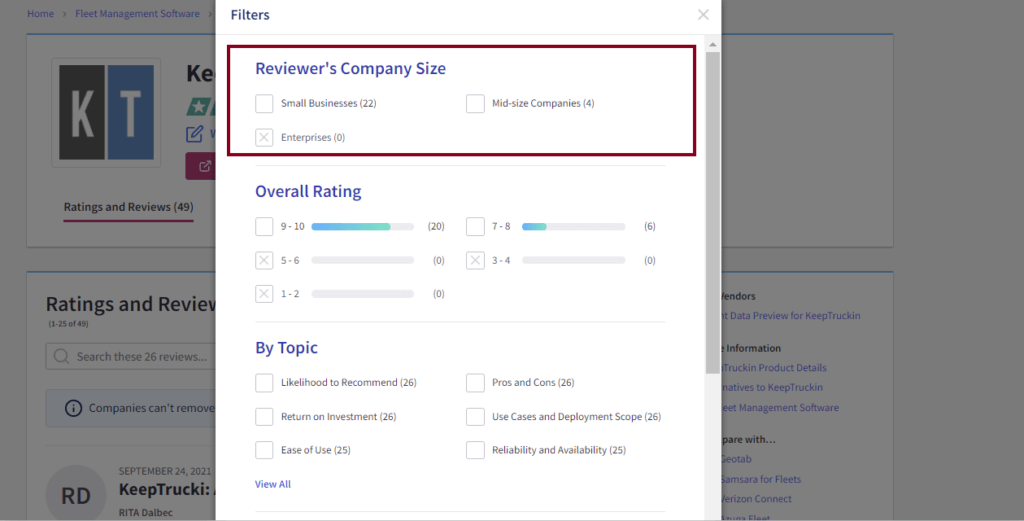How To Chose the Best Fleet Management Software
Fleet management software allows organizations to help with the daunting tasks like organizing vehicles, drivers, incidents, and so much more. The right software can simplify this logistical quagmire and unlock the potential of your organization. As such, there is a huge array of options available. Fortunately, by breaking down your needs, limits, and scale, you can choose the best fleet management software for your budget.
In this piece, we will cover:
With all of these features in mind, you will have a much better picture of exactly what you are looking for. With that, we can start to look at some of the software out there.
Fleet Management Pricing
A software could do everything you ever dreamed of and more, but be utterly useless if it is too expensive for your budget. The first and potentially most important part of any software discussion is a rough guide to pricing.
As a general rule, fleet management software will cost you about $25-40 per vehicle. The extremes can range from $5-$250 per vehicle, but these tend to be for very specific use cases.
Other costs can include hardware that may or may not be included in a vendor’s pricing. GPS systems and dashcams are common extras, and may cost extra. Installation of these may not be free, along with shipping costs. Because of these costs, set-up can be more expensive than a simple matter of the per-vehicle cost multiplied by the size of your fleet. Ensure to get a final total quote from any vendor before purchase.
In order to get the best bang for your buck, it’s best to go for a company that is targeting your specific company size. Pricing models can be far more efficient for smaller companies when they are offered by vendors that want to cater to their needs. For this reason, scale and scalability is the next point of discussion.
Scale and Scalability of Fleet Management Tools
When picking the right tool for you, identify your size and speed of growth. Companies more secure in their position can look at the pricing that best suits them. Fast-growing organizations should ensure their fleet management tool can grow with them.
Thankfully, TR has you covered. For any software on our website, you can sort the reviews by company size, as shown below. This will make sure you are finding those with glowing reviews from users most similar to you.

For those growing fast with tight budgets, a per-vehicle pricing model can be best. This allows you to easily factor in the fleet management software costs to any budgeting and planning that comes before expansions.
Some tools, like Verizon Connect, start off with surveys and tailor their service based on your answers. Even if you do not choose this software, these quizzes can be a good way to hone your perspective.

What Features Do You Need in Fleet Management Software?
Once you have the scale and a rough budget established, you can get into the fun parts: what you’re getting for your money. These features fall into a few rough categories:
- Vehicle Management
- Driver Management
- Incident Management
- Tracking
Vehicle management features are some of the most immediately obvious for fleet management software. These include maintenance records, registry and tax information, and more. Advanced tools may include vehicle cost analysis and disposal assistance. These are fantastic at ensuring regulatory and functional standards are met. Abiding by such standards helps your fleet run smoothly and within compliance.
Driver management, as the name suggests, focuses on organizing your team members and all that goes with them. These can handle licensing and penalty management. Those who pool their vehicles between drivers can often find tools to help with that logistical problem.
Drivers’ safety records and their performance can also be organized here. For owners and managers, this allows for immediate access to information for accountability and performance. These are also useful for legal issues that can come from the variety of industries that use fleet management software.
In the imperfect world fleets operate in, incidents happen, and a common feature of fleet tracking is incident management. These can add a level of objectivity and organization to a chaotic process. Users can keep track of costs, incidents, and assign costs to drivers and insurance as needed.
Finally, tracking systems allow for some of the real-world data to be available to all facets of the company. This can be as simple as answering the question “where is x vehicle”, to more advanced features like fuel tracking and analysis. The software can help you eliminate waste with telematics, route planning and more. These also handle more basic functions such as logbooks and working time calculations.
It sounds simple, but it is essential to pay for what you need and not more. With the high ceiling for costs in the fleet management world. If you do not need more advanced analytics, do not pay for them. Budget options like Fleetio can slash costs to around $5 per vehicle per month for those looking for simple, logistical features.
Mobility: Will your Fleet Management Move with you?
While the options for puns in a mobility section are huge, the question is somewhat simple: What features do you need to move with your vehicles, what can stay home?
The most basic fleet management software operates as logistical organizing tools that rely on reporting when your vehicles get home. This may require your drivers to keep receipts from gas stations. These also do not allow for live tracking or accountability.
Others may watch your vehicle’s cabin, front and rear view, allow for live incident logging, and much, much more. The middle ground is use of a live service app.
The best question to ask of a vendor to start for most small-to-mid-sized companies is: “what services does your app provide?” This will give a strong overview of what will be expected of your drivers when they are en-route, and what information you will get during that time.
Ease of Use and Integration
These are simple questions with huge consequences for your workforce. More experienced drivers at large organizations can be expected to handle complex, advanced fleet management processes. Those at smaller organizations may need more extensive training to take advantage of such tools.
As a general rule, the more you are paying for a tool and the more features there are, the more experience required to get the most out of it. Check out reviews from users of your company size for perceptions on the user interface and experience.
Integrations can make or break a tool for some use cases. For those using logistical or employee management tools, check to see if you can cut out the middle man by picking a tool that integrates directly. If you are looking at lower-cost options and planning on getting advanced features from other tools piecemeal, make sure they work well together.
Final Recommendations:
No matter what software you choose, make sure to read the experiences of those who have already paid for it. Check out the link below to explore all the fleet management options on TrustRadius.
For those new to the industry, or who want to improve their organization, check out the video below. There you will find a guide on fleet management and fleet planning.
Was this helpful?

Looking for your next fleet management software? Start by reading 100% authentic reviews from users just like you.
